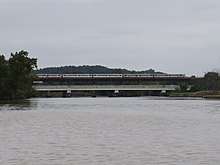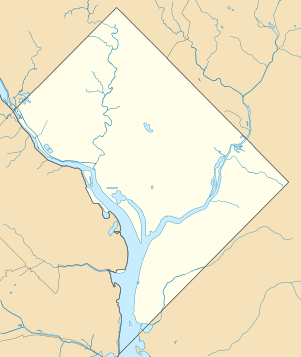Ethel Kennedy Bridge
| Ethel Kennedy Bridge | |
|---|---|
 The Ethel Kennedy Bridge from the south in 2018, with the Metro bridge visible behind and above it | |
| Coordinates | 38°53′50″N 76°57′49″W / 38.897195°N 76.963649°WCoordinates: 38°53′50″N 76°57′49″W / 38.897195°N 76.963649°W |
| Carries | Motor vehicles, pedestrians |
| Crosses | Anacostia River, Kingman Island |
| Locale | Washington, D.C., U.S. |
| Other name(s) | Benning Road Bridge |
| Owner | District Department of Transportation |
| Preceded by | Washington Metro bridge |
| Followed by | Whitney Young Memorial Bridge |
| Characteristics | |
| Design | Plate girder bridge |
| Total length | 548 feet (167 m)[1] |
| No. of spans | 5 |
| History | |
| Rebuilt | 1961 (eastbound structure), 1934 (westbound structure), 2011-12 (replacement) |
| Statistics | |
| Daily traffic | 68,400 vehicles per day (1990)[2] |
| Toll | Free both ways |
 Ethel Kennedy Bridge Location in the District of Columbia | |
The Ethel Kennedy Bridge is a beam bridge carrying Benning Road over the Anacostia River and Kingman Island in Washington DC. It is a eight-lane bridge with pedestrian lanes on both sides. A separate Washington Metro bridge carrying the Blue, Orange and Silver lines crosses over the bridge near its western terminus, and parallels the bridge on the north.
History

In 1797, the state of Maryland (which then controlled the area which would later become the District of Columbia) issued a charter to Benjamin Stoddert, Thomas Law, and John Templeman to build a bridge across the Anacostia River.[3][4] Stoddert owned land (known as "Long Meadows") on the eastern shore of the Anacostia River, and a bridge would have helped him develop him land.[3] The right to build a bridge was not exercised until 1805, when Chain Bridge was swept away during floods.[3][4] Stoddert then formed the Anacostia Bridge Co., and that same year erected a $20,000 wooden bridge known as Stoddert's Bridge in this location.[3][4] In the 1790s, "Captain" William Benning came from Virginia and purchased 330 acres (1.3 km2) of land on the western end of Stoddert's Bridge.[5] The site was one of the first crossings over the Anacostia River.[6] The bridge and "Benning's Road" were important eastern routes in and out of the District.[6][7][8]
By 1814, the bridge—now also known as "Upper Bridge"—was in disrepair.[9] During the War of 1812, the U.S. military commander of the Military District of Washington burned Stoddert's Bridge in an attempt to stop the British from invading the city of Washington.[10][11] On March 3, 1815, the United States Congress passed legislation reimbursing the Anacostia Bridge Co. for the destruction of its bridge.[12]
The bridge was rebuilt in 1815 by Dr. Thomas Ewell, who renamed it Ewell's Bridge (although it was also known as the "Anacostia Bridge").[13] In 1825, Ewell sold the bridge to Benning, who renamed it Benning's Bridge.[13] Benning built a new bridge at the site in the 1830s (although not all sources agree on the exact date).[14]
After a major flood in 1840, the bridge was repaired.[11] It was purchased in August 1848 by the federal government and the toll removed.[15] In disrepair due to the large amount of traffic over the span, it was almost completely rebuilt in 1868.[16] The structure was replaced with a steel bridge in 1892,[17][18] and a concrete bridge in 1934.[11] A second concrete bridge was constructed in 1961; the old span now carried eastbound traffic, while the new span carried only westbound traffic.[2]
In 2011-2012, the Benning Road Reconstruction Project replaced the two concrete spans dating from 1934 and 1961 with a single 548-foot, 8-lane, 5-span, continuous, multi-girder bridge with steel elements masked by concrete panels to closely resemble the 1934 span.[19][1][20]
The Bridge was inspected by the District of Columbia Department of Transportation (DDOT) in 2014, and found to be structurally sound.[21]
In 2008, the District Council voted to rename the Benning Road Bridge after Ethel Kennedy, the widow of the late Robert F. Kennedy, for whom a nearby stadium was named. In a May 20, 2014, the bridge was officially renamed the Ethel Kennedy Bridge to honor her for her devotion to many social and environmental causes during her later years, especially in the neighborhoods along and near the Anacostia River.[22]
References
- 1 2 "Benning Road Bridge Replacement over the Anacostia River | Volkert Engineering, P.C." volkertengineering.com. Volkert Engineering, P.C. Retrieved October 11, 2018.
- 1 2 2009 Data. National Bridge Inventory. Federal Highway Administration. United States Department of Transportation. 2009. Accessed 2010-07-05.
- 1 2 3 4 Bryan, Wilhelmus Bogart. A History of the National Capital From Its Foundation Through the Period of the Adoption of the Organic Act. Vol. 1. New York: The Macmillan Company, 1914, p. 492.
- 1 2 3 Croggon, James. "When City Was Young." Washington Evening Star. August 17, 1906.
- ↑ Deanwood History Committee. Washington, D.C.'s Deanwood. Charleston, S.C.: Arcadia Publishing, 2008, p. 7.
- 1 2 Lapp, Joe. Kenilworth: A D.C. Neighborhood by the Anacostia River Archived 2010-05-27 at the Wayback Machine. (Humanities Council of Washington D.C. 2006), Accessed May 7, 2010
- ↑ Joe Lapp (November 2005). "Kenilworth: A Northeast Neighborhood by the Anacostia River" (PDF). East of the River. Retrieved May 7, 2010.
- ↑ Upper Marlboro-East Washington, DC Quadrangle, Northwest Quadrant, USGS (1886)("Benning's Road" appears on 1886 USGS Map)
- ↑ Lord, Walter. The Dawn's Early Light. Baltimore, Md.: Johns Hopkins University Press, 1994, p. 93.
- ↑ Lord, The Dawn's Early Light, 1994, p. 96; Muller, Charles Geoffrey. The Darkest Day—1814: The Washington-Baltimore Campaign. Philadelphia: University of Pennsylvania Press, 2003, p. 111.
- 1 2 3 Wheeler, Linda. "Benning Heights' Twists and Turns." Washington Post. October 25, 1997.
- ↑ Maggie Houston. Report No. 587. Committee on War Claims. U.S. House of Representatives. 52d Cong., 2d Sess. March 14, 1894, p. 6.
- 1 2 Bryan, Wilhelmus Bogart. A History of the National Capital From Its Foundation Through the Period of the Adoption of the Organic Act. Vol. 2. New York: The Macmillan Company, 1916, p. 98-99.
- ↑ "Local roads scholars give streets'history". The Washington Times. June 25, 1992. Retrieved May 7, 2010.
- ↑ Turnpike Roads in District of Columbia. Minority Report. Committee on the District of Columbia. U.S. House of Representatives. Report No. 410. 35th Cong., 1st Sess. May 24, 1858, p. 2.
- ↑ Letter of the Secretary of War, March 22, 1869. Exec. Doc. No. 100. United States Senate. 41st Cong., 1st Sess. June 20, 1870, p. 2.
- ↑ Wasserman, Paul & Hausrath, Don. Washington, D.C. From A to Z, p.33 (2003) ( ISBN 978-1931868075)
- ↑ Scott, Pamela. Capital Engineers: The U.S. Army Corps of Engineers in the Development of Washington, D.C., 1790-2004. Washington, D.C.: U.S. Army Corps of Engineers, 2007, p. 124.
- ↑ "Benning Road Reconstruction Project | ddot". ddot.dc.gov. District Department of Transportation. Retrieved October 11, 2018.
- ↑ "Benning Road Bridge Replacement | Volkert". volkert.com. Volkert, Inc. Retrieved October 11, 2018.
- ↑ Dildine, Dave (June 25, 2015). "DDOT details area's structurally deficient bridges". WTOP. Retrieved September 1, 2015.
- ↑ DeBonis, Mike (May 21, 2014). "Ethel Kennedy Bridge is dedicated, at long last". Washington Post. Retrieved 11 April 2016.
| Wikimedia Commons has media related to Benning Bridge. |